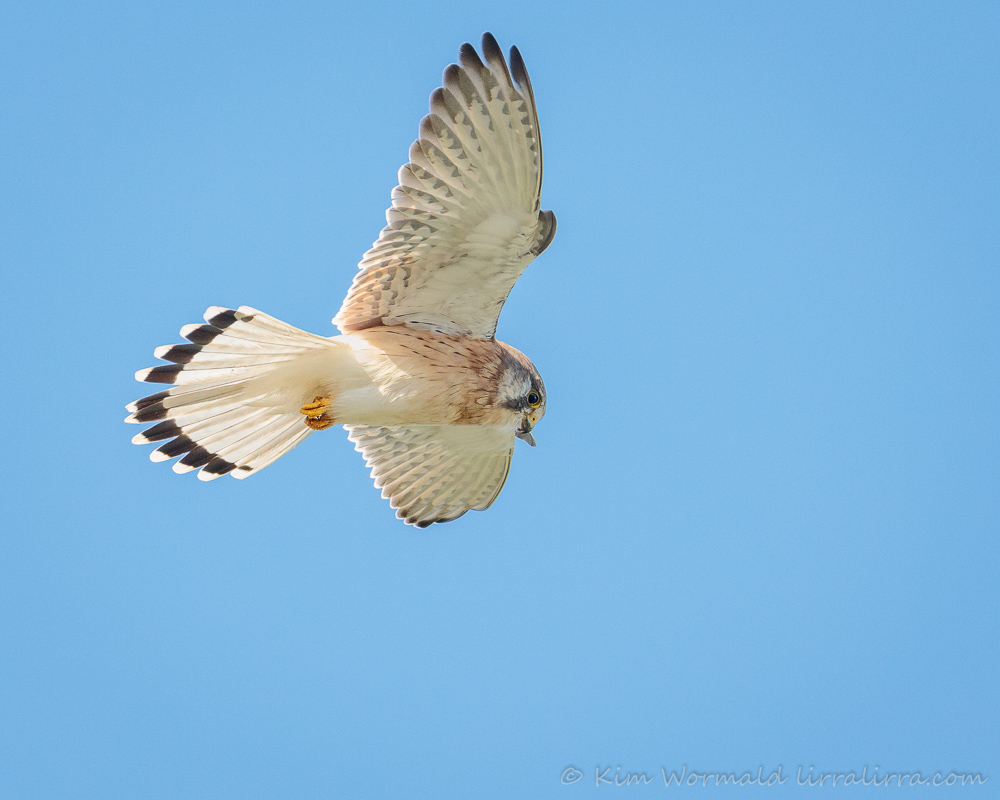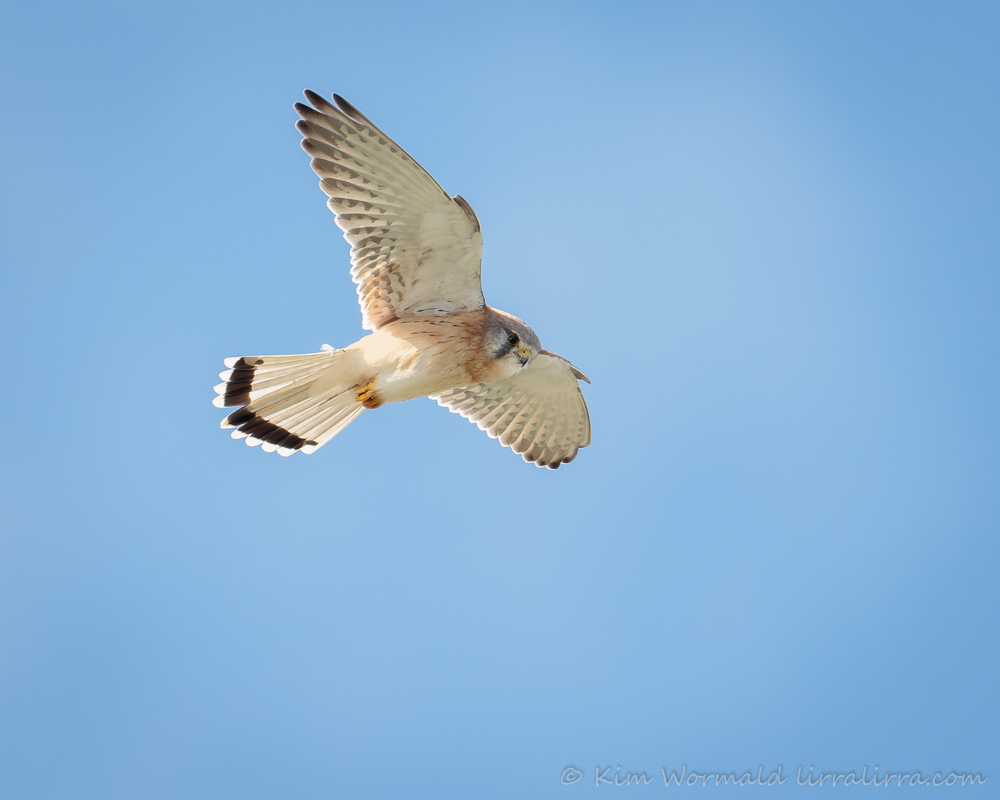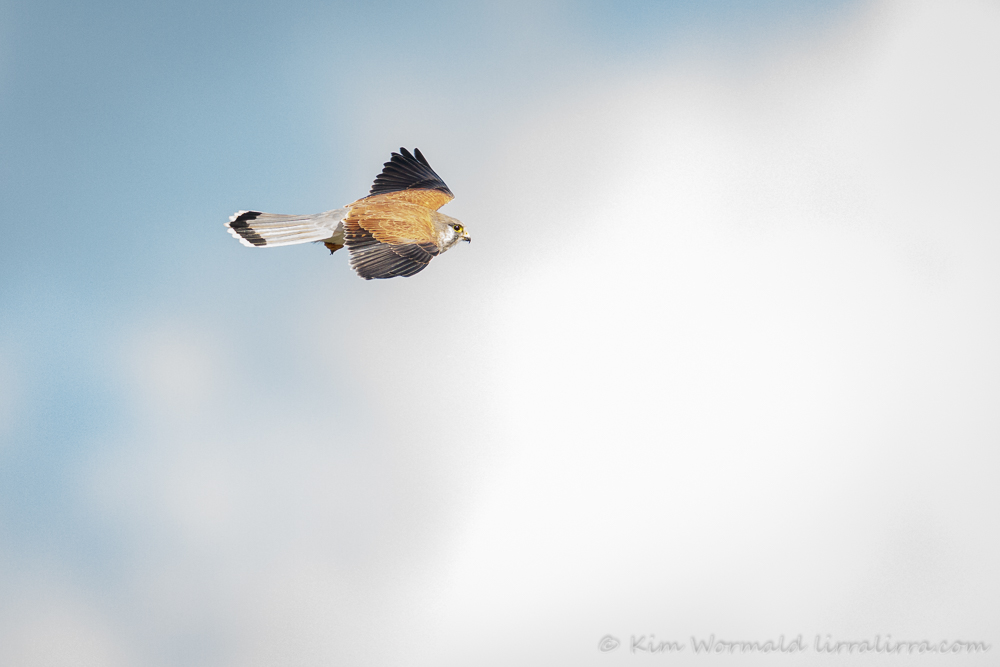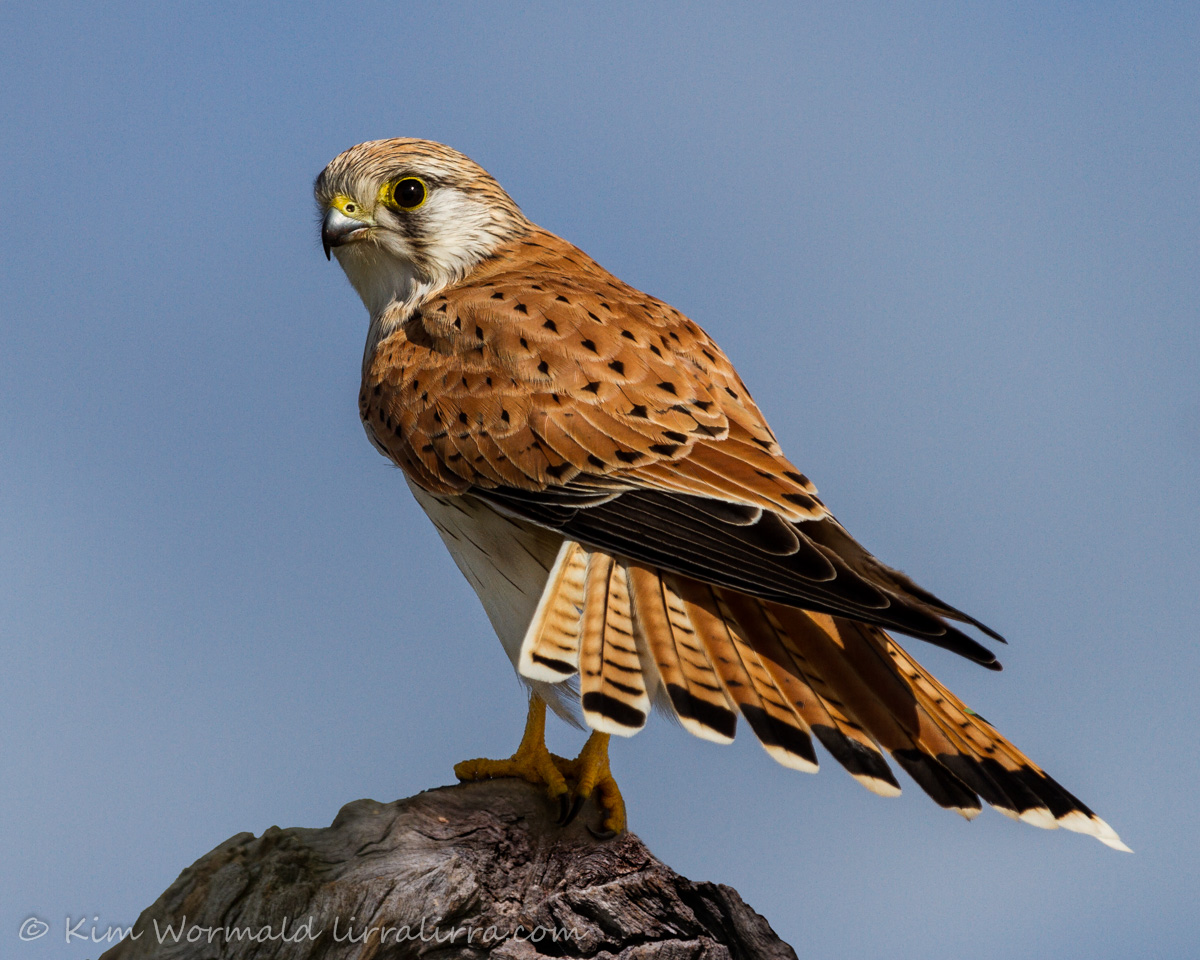Despite the midday light it was spectacular to watch Australia’s smallest falcon, the Nankeen Kestrel, hovering, diving and eating its prey on the wing.

Nankeen Kestrel (Falco cenchroides) – male
1/2000, f/5.6, ISO 1600
Nankeen Kestrels are Australia’s smallest falcons, females are larger than males but the average size of the species is about 34cm and 170g. This kestrel can easily be identified as a male due to his grey head and tail. Females are marked quite differently, as I show later in the post.

Nankeen Kestrel (Falco cenchroides)
1/2000, f/5.6, ISO 1600
It has been suggested that Kestrels have remarkable vision that enables them to see ultra violet light and thereby track urine trails and find prey. More recent studies are questioning this and speculating that songbirds can have superior UV vision and that UV cues are ‘of little or no importance to raptors‘ – maybe one day soon we’ll know more.

Nankeen Kestrel (Falco cenchroides)
1/1000, f/5.6, ISO 800
Kestrels are beautiful marked raptors with striated underparts, a black band across the tail and yellow ceres, eye-rings and feet. They have a distinctive dark ‘tear drop’. They hover and study the ground for prey before diving to catch a small mammal, reptile or a large insect. They often eat their prey in flight after rapidly diving and quickly changing direction to capture prey in their talons. They are capable of catching insects, and occasionally birds, on the wing.

Nankeen Kestrel (Falco cenchroides)
1/1250, f/5.6, ISO 1600
Not only was this kestrel out and about in the middle of the day but it also flew in circles to cover areas of grass and rock, because of this the lighting and backgrounds of the images are quite different. Sometimes the bird was backlit while other times it was in direct sunlight, and to add another variable sometimes the sun went behind clouds. I kept changing the exposure but it was tricky to get enough information in the darker areas without over-exposing the lighter areas.

Nankeen Kestrel (Falco cenchroides)
1/1250, f/5.6, ISO 1600
The kestrel was a fair distance away in these images so they have been quite heavily cropped but I think there is enough detail captured for the images to be pleasing. Hopefully next time I’m able to watch a kestrel the lighting will be less contrasty and the bird will be closer.

Nankeen Kestrel (Falco cenchroides)
1/1000, f/5.6, ISO 800
This is an image of a female Nankeen Kestrel that I took some time ago. Her head and tail are rufous rather than grey, and her tail has more barring – it’s unusual for female birds to be more striking in appearance than males, but I think she’s stunning.
Happy birding, Kim
Update on the Victorian duck shooting season
After last week’s great news about Animals Australia’s ‘Duck Shooting Destroys Families‘ bus ads, the news this week is horrendous.
Jaala Pulford, Minister for Agriculture, gave a gazetted commitment that Lake Elizabeth would be closed for the duration of the 2016 duck shooting season due to the presence of Blue-billed Ducks. This commitment was given half an hour before ‘an urgent injunction application was set to be heard by the Victorian Supreme Court’, see AA’s press release here . Minister Pulford has reneged on this commitment and Lake Elizabeth was quietly opened to shooters on Wednesday of this week. The Coalition Against Duck Shooting and Animals Australia were prepared for the change and had a team at the lake at first light on Wednesday. Five police vehicles were in attendance, along with six shooters – only twenty shots were fired – duck shooting is a dying sport.
Lake Elizabeth is part of the Kerang RAMSAR wetlands, if you are able to be part of the team at Lake Elizabeth this weekend please contact the Coalition Against Duck Shooting at info@duck.org.au – it’s great when duck rescuers outnumber the shooters.
~ Thank you for visiting and commenting
~ If you would like to join subscribers who receive a weekly email letting them know that lirralirra has been updated please use the ‘subscribe’ box above right

Are you kidding? Those are AMAZING shots on the wing. So hard to get focus and light and….. You just amaze me!
Thank you Sherry! Your lovely comment sure made me smile 🙂
Beautiful shots, Kim, especially that arresting image of the bird perched. Feel this is yet another common species that has all but disappeared off the radar. Once met with so often that you only gave them attention when mesmerised by their capacity to hover endlessly. Now, honestly can’t remember the last time I saw one. We lose so much! Just like that.
There used to be many diurnal raptor species around our place which have dwindled now to visits from sparrowhawks, goshawks and Wedge-tailed Eagles. I’m glad you like the images and hope you get to be mesmerised by a hovering kestrel soon.
Your attention to detail is obvious. The light brings out the colors of the plumage so nicely Kim. Wonderful shot!
Thank you Frank. I am an unabashed pixel peeper.
Fabulous pics again Kim especially like the last one, Queenly is an apt description.
There is something regal about her now you mention it!
Fantastic pics Kim wasn’t sure about the raptor of auz till now. Good job
There are lots of magnificent raptors here, we’re super lucky. Come for a visit, bring the family!
Superb work again, Kim
Re the politician’s back-flip, it reminds and justifies the joke, “How do you know when a politician is lying?” Answer: “Their lips are moving.”
How sad that a joke like that is even created let alone true.
I’m pleased you liked the images Neil.
I don’t have words to express how beautiful they are!
fabulous, superb, stunning 🙂
Aw thank you Genevieve, I’m so pleased that you enjoyed the kestrels 🙂
Reneged on the commitment? Hiss and bloody spit. And repeat. That is an act of bastardry. And no, I won’t apologise for the intemperate words.
Changing the subject (rapidly) I love, love, love your Kestrel shots. They are a truly beautiful bird. And hunt as it should be done. Out of necessity, not for sport.
It was very upsetting, I don’t usually wish time to pass any more quickly than it already does but I’ll be pleased to see the end of the shooting season. Kestrels are beautiful,I always enjoy seeing them.
Well done for your great pictures Kim, “j’adore” in french ;-))
Hi Alain! Thank you, merci beaucoup mon ami 🙂
Tremendous shot of the close up of the female.
Thank you Togram, I was lucky to see her in such unique pose